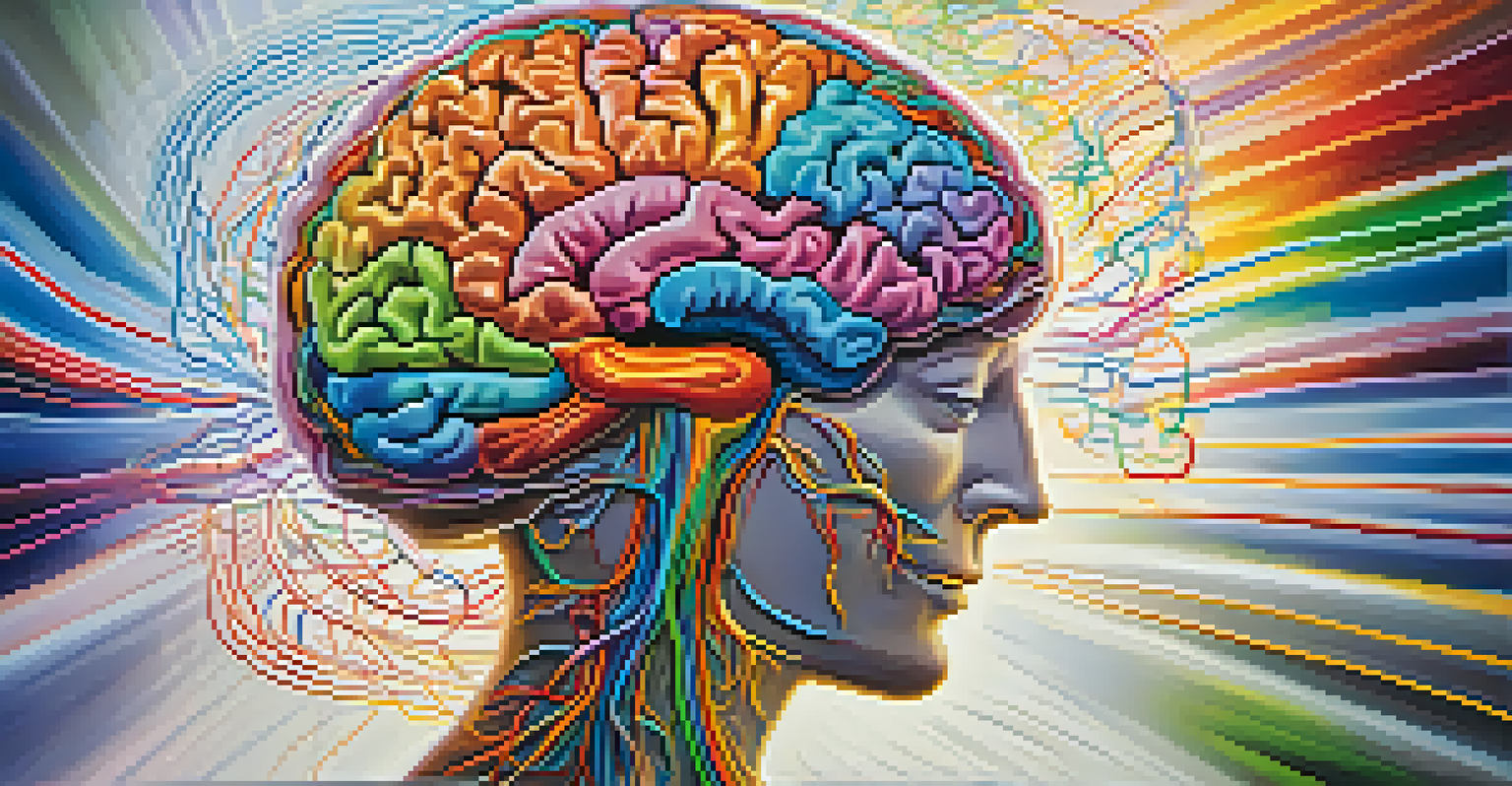Entheogens: Bridging the Gap Between Mind and Spirit

What Are Entheogens and Their Historical Context?
Entheogens are substances that induce altered states of consciousness, often used in spiritual or religious contexts. These natural compounds, like psilocybin from mushrooms or ayahuasca from the Amazon, have been utilized for centuries by various cultures. They are believed to facilitate profound experiences that connect individuals to a higher reality or inner self, often described as spiritual awakenings.
Psychedelics can help us uncover the mysteries of our consciousness, revealing deeper truths about ourselves and the universe.
Historically, indigenous tribes have employed entheogens in rituals to gain insight, heal, or communicate with the divine. For instance, the use of peyote among Native American tribes showcases how these substances play a vital role in cultural traditions. With modern interest in these ancient practices, many are revisiting the wisdom of our ancestors in understanding consciousness and spirituality.
As we explore the historical significance of entheogens, it’s essential to recognize not only their cultural roots but also their potential to bridge the gap between mind and spirit. This reconnection with ancient practices opens the door to a deeper understanding of human consciousness and the mysteries of our existence.
How Entheogens Affect the Mind and Body
Entheogens interact with our brain's neurotransmitters, leading to altered perceptions and enhanced emotional experiences. For instance, substances like LSD and psilocybin primarily affect serotonin receptors, which can shift our mood and sense of self. This biochemical interaction sparks a cascade of effects, often resulting in vivid imagery, deep introspection, and a feeling of connectedness to the universe.

While these substances can produce profound insights, they also require careful consideration regarding dosage and setting. The environment in which one consumes an entheogen can significantly shape the experience, highlighting the importance of intention and mindset. This is why many practitioners advocate for guided sessions or rituals to ensure a safe and meaningful journey.
Entheogens and Spiritual Traditions
Entheogens have been used for centuries in various cultures to facilitate spiritual experiences and connect individuals to a higher reality.
Ultimately, understanding the physiological effects of entheogens can help demystify their power. By exploring how they influence our body and mind, we can appreciate their potential to facilitate spiritual growth and self-discovery.
The Spiritual Significance of Entheogenic Experiences
Many users report experiencing profound spiritual insights and connections while under the influence of entheogens. These experiences can range from feelings of unity with nature to encounters with what they perceive as divine entities. Such transformative moments often leave lasting impressions, prompting individuals to reevaluate their beliefs and values.
The experience of the sacred is not a thing of the past; it is something we can rediscover in the present through the use of entheogens.
For many, these substances serve as a catalyst for personal growth, allowing them to confront fears and unresolved issues. This process can be likened to peeling back layers of an onion, revealing deeper truths about oneself. The spiritual significance of these revelations often leads to a greater sense of purpose and direction in life.
In a world increasingly disconnected from nature and spirituality, entheogens can offer a pathway back to these essential aspects of human existence. They remind us of our inherent connection to something greater than ourselves, inviting us to explore the depths of our consciousness.
Modern Research and Therapeutic Uses of Entheogens
In recent years, scientific research has begun to uncover the therapeutic potential of entheogens in treating mental health conditions like depression, anxiety, and PTSD. Studies have shown that psychedelics can lead to significant improvements in mood and outlook, often after just a few sessions. This resurgence of interest is prompting a reevaluation of the stigma surrounding these substances.
For example, clinical trials involving psilocybin have shown promising results in helping patients confront their fears and gain clarity on their life’s purpose. The therapeutic framework often emphasizes integration, where experiences are processed and understood in a supportive environment. This aspect is crucial, as it helps individuals translate their psychedelic experiences into meaningful changes in their daily lives.
Therapeutic Potential of Entheogens
Recent studies suggest that entheogens like psilocybin may effectively treat mental health conditions such as depression and PTSD.
As we continue to explore the medical applications of entheogens, it’s vital to approach this field with both curiosity and caution. The intersection of science and spirituality in this domain opens up exciting possibilities for healing and understanding the human experience.
Navigating the Ethical Considerations of Entheogens
The growing popularity of entheogens raises important ethical questions regarding their use and accessibility. As these substances move from underground practices to mainstream acceptance, considerations around safety, legality, and cultural appropriation become increasingly relevant. It’s essential to honor the traditions of indigenous peoples who have used these substances for generations.
Moreover, the commercialization of entheogens can lead to a dilution of their spiritual significance. When approached purely as recreational substances, we risk losing the depth of the experiences they can provide. Ethical usage emphasizes respect for the plant, its origins, and the cultural practices surrounding its use.
Navigating these ethical considerations requires an open dialogue and a commitment to responsible practices. By fostering a respectful relationship with entheogens, we can ensure that they are used in ways that honor their historical and spiritual significance.
Personal Growth Through Entheogenic Journeys
Many individuals embark on entheogenic journeys in search of personal growth and self-discovery. These experiences can illuminate aspects of ourselves that we may not fully understand, allowing for greater self-awareness. The insights gained during these journeys often lead to transformative changes in behavior and mindset.
People frequently share stories of how entheogens have helped them overcome obstacles, whether emotional, psychological, or relational. The process of confronting inner demons can be challenging, but it often results in profound healing and clarity. It’s akin to shining a light in a dark room, revealing hidden corners that need attention.
Ethical Use and Cultural Respect
The rise in entheogen popularity necessitates an ethical approach that honors indigenous traditions and ensures responsible use.
Ultimately, personal growth through entheogenic experiences is a deeply individual journey. Each person’s path is unique, shaped by their intentions, backgrounds, and experiences. By embracing this journey, many find renewed purpose and a deeper connection to themselves and the world around them.
The Future of Entheogens in Society and Spirituality
As society continues to explore the role of entheogens, we may witness a shift in how we perceive spirituality and consciousness. With increasing acceptance and research backing their benefits, these substances could become integral to personal development and mental health treatments. This evolving landscape encourages a holistic approach to wellness that embraces both mind and spirit.
Additionally, the integration of entheogens into mainstream spirituality could foster greater understanding and compassion among individuals. As people share their experiences and insights, we may cultivate a community that values connection and empathy. This collective journey could lead to a more profound appreciation for the diverse ways in which humanity seeks meaning.

Looking ahead, the future of entheogens holds immense potential for enriching our understanding of consciousness and spirituality. By bridging the gap between ancient wisdom and modern science, we can create a more compassionate and enlightened society.